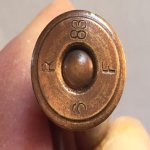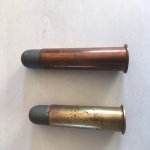Ok, I finally got a chance to go through an auction purchase of some vintage ammo. One part of it is eight rounds of 45-85 Springfield. They appear very similar to a 45-90 yet I have no literature on a 45-85 "Springfield". Is it the same cartridge as the Winchester? The case appears to be copper & has a head stamp of "R" & bellow the primer & an "F". On the horizontal is a single digit on the left side (varies) & either a "81", "82" or "83" on the other side. I'm assuming that is the month & year of manufacture. One of the cartridges written in marker states "45-85 Springfield Sniper". Not sure what that means or if it matters. It's a lead round nose bullet of impressive weight. I'll try & get some pics in the next couple of days. I'm of the mindset that it's just one of the variations of the 45-90, but any information on this round is greatly appreciated.
-Dances
-Dances











































































